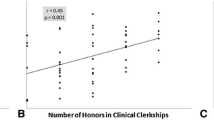Abstract
Surveys have suggested one of the most important determinants of orthopaedic resident selection is completion of an orthopaedic clerkship at the program director’s institution. The purpose of this study was to further elucidate the significance of visiting externships on the resident selection process. We retrospectively reviewed data for all medical students applying for orthopaedic surgery residency from six medical schools between 2006 and 2008, for a total of 143 applicants. Univariate and multivariate regression analyses were used to compare students who matched successfully versus those who did not in terms of number of away rotations, United States Medical Licensing Examination® scores, class rank, and other objective factors. Of the 143 medical students, 19 did not match in orthopaedics (13.3%), whereas the remaining 124 matched. On multiple logistic regression analysis, whether a student did more than one home rotation, how many away rotations a student performed, and United States Medical Licensing Examination® Step 1 score were factors in the odds of match success. Orthopaedic surgery is one of the most competitive specialties in medicine; the away rotation remains an important factor in match success.
Similar content being viewed by others
References
Bajaj G, Carmichael KD. What attributes are necessary to be selected for an orthopaedic surgery residency position: perceptions of faculty and residents. South Med J. 2004;97:1179–1185.
Bernstein AD, Jazrawi LM, Elbeshbeshy B, Della Valle CJ, Zuckerman JD. Orthopaedic resident-selection criteria. J Bone Joint Surg Am. 2002;84:2090–2096.
Clark R, Evans EB, Ivey FM, Calhoun JH, Hokanson JA. Characteristics of successful and unsuccessful applicants to orthopedic residency training programs. Clin Orthop Relat Res. 1989;241:257–264.
Donini-Lenhoff F, ed. Graduate Medical Education Directory. Chicago, IL: American Medical Association; 2000–2001:181.
Hsieh FY, Bloch DA, Larsen MD. A simple method of sample size calculation for linear and logistic regression. Stat Med. 1998;17:1623–1634.
Lostumbo EM, Beran RL. Results of the National Resident Matching Program for 2002. Acad Med. 2002;77:587–590.
National Resident Matching Program and Association of American Medical Colleges. Charting Outcomes in the Match. Available at: http://www.nrmp.org/data/chartingoutcomes2007.pdf. Accessed July 27, 2008.
Scherl SA, Lively N, Simon MA. Initial review of Electronic Residency Application Service charts by orthopaedic residency faculty members: does applicant gender matter? J Bone Joint Surg Am. 2001;83:65–70.
Signer MM, Beran RL. Results of the National Resident Matching Program for 2005. Acad Med. 2005;80:610–612.
Simon MA. The education of future orthopaedists: deja vu. J Bone Joint Surg Am. 2001;83:1416–1423.
Wagoner NE, Suriano JR. Program directors’ responses to a survey on variables used to select residents in a time of change. Acad Med. 1999;74:51–58.
Acknowledgments
We thank all of the medical schools who participated in our survey.
Author information
Authors and Affiliations
Corresponding author
Additional information
Each author certifies that he or she has no commercial associations (eg, consultancies, stock ownership, equity interest, patent/licensing arrangements, etc) that might pose a conflict of interest in connection with the submitted article.
About this article
Cite this article
Baldwin, K., Weidner, Z., Ahn, J. et al. Are Away Rotations Critical for a Successful Match in Orthopaedic Surgery?. Clin Orthop Relat Res 467, 3340–3345 (2009). https://doi.org/10.1007/s11999-009-0920-9
Received:
Accepted:
Published:
Issue Date:
DOI: https://doi.org/10.1007/s11999-009-0920-9




